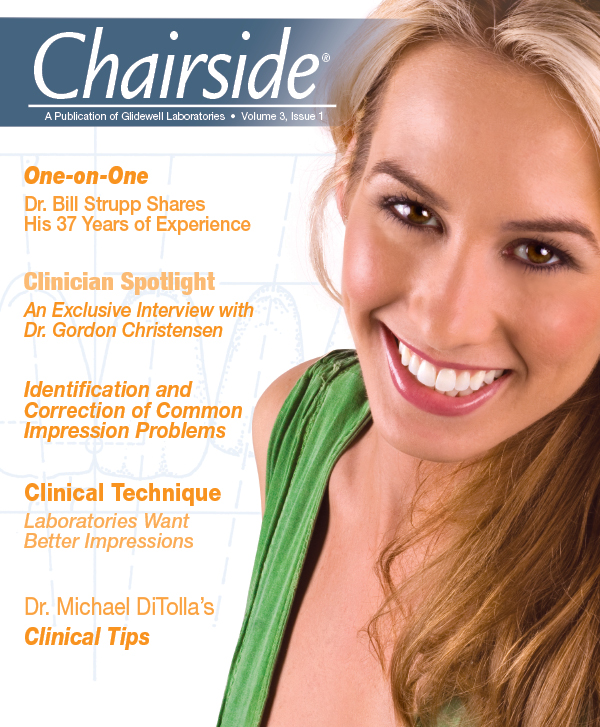Letters to the Editor
Dear Dr. DiTolla,
I am enjoying very much your articles and videos for better dentistry! I just read an article in Vol. 2, Issue 2 of Chairside® and had a few questions regarding Diagnostic Wax-Ups:
1. What is the cost involved for Glidewell Labs to do an esthetic wax-up for a specific case?
2. I’m having trouble with temps for prepped veneer cases. I like your technique using the putty material with LuxaTemp® (Zenith/DMG; Englewood, N.J.). I notice you just leave it in place after forming the temps in the mouth. Do you have trouble with sensitivity or stain leaking under the margins when using no cement? Also, how strong are these temps?
3. Lastly, are there other materials as good as LuxaTemp, or is that the best one around? Thanks for your help.
– Curt Mathisen, DDS
White Salmon, WA
Dear Curt,
A Diagnostic Wax-Up is $25 per tooth. Many times I feel like if the patient isn’t willing to pay to see what their veneers will look like, then they are not ready to commit at that time. It is a screening of sorts to determine who is serious about treatment.
In regards to mechanically locking on the veneer temps, I don’t have too many problems with sensitivity, although most of my veneer preps stay within the enamel. I know people who put a desensitizer like Tubulicid Red down and then dry it prior to placing the temps, but I don’t do that.
I have the same amount of staining that I did with cemented temps, and we warn people to stay away from dark colored foods and drinks. The worst staining I have ever seen was a guy who went to a bachelor party and smoked three cigars. They were black underneath, but not sensitive. Hydrogen peroxide removes those stains quickly and easily. Temp veneers are a necessary evil, and we simply try to get people through those two weeks understanding they have thin little plastic facings hanging on to their teeth. No temps is definitely an advantage of no-prep and minimal-prep veneers!
I use LuxaTemp because of habit, but I have used other bisacryl materials as well. They all seem to work the same, so any one should work just fine. I hope that helps!
– Dr. DiTolla
Dear Dr. DiTolla,
Could you please tell me what you use to adjust and polish porcelain crowns and bridges, both intraorally and extraorally, from rough polishing to final polish? A lab that I no longer use had sent wheels for my lab mandrels, but I can no longer find them.
I am looking for a good, practical system, even if the pieces are from different manufacturers. Thank you!
– Carlos Boudet, DDS
West Palm Beach, FL
Dear Carlos,
I hope all is well with you and the practice!
To polish porcelain well you MUST have an electric handpiece. I have a Benchtop electric handpiece from KaVo (Charlotte, N.C.) for out-of-the-mouth polishing, and I use a KaVo ELECTROtorque handpiece for intraoral polishing (and all prepping).
I like the Axis CeraGlaze® (Coppell, Texas) wheels, cups and points for polishing, with the straight mandrels for out of the mouth and the latch mandrels for intraoral polishing. I hope that helps!
– Dr. DiTolla


